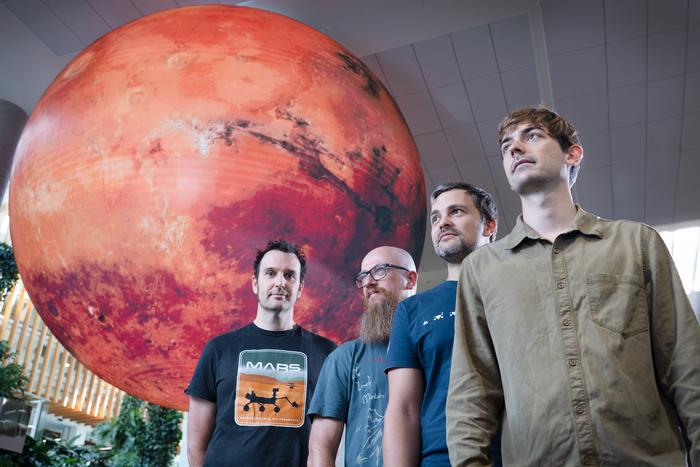A groundbreaking study spearheaded by researchers from the Queensland University of Technology (QUT) has unveiled significant insights into the enigmatic history of Mars, leveraging data obtained from NASA’s Perseverance Rover. This pivotal research not only seeks to unlock answers surrounding the potential existence of life on the Red Planet but also enhances our understanding of the mineralogical transformations that have taken place beneath its surface.
The study reveals compelling evidence of multiple mineral-forming events that could reshape our comprehension of Martian geological history. These discoveries bring humanity closer to fundamentally understanding the conditions that existed on Mars, particularly during epochs that may have been conducive to supporting microbial life. Dr. Michael Jones, leading the QUT research team, articulates a sentiment echoed by many scientists: understanding Mars’ habitability hinges on deciphering the planet’s complex geological narrative.
Through meticulous analysis of sulfate minerals identified in Martian rock, the research team aimed to unravel the mystery of Mars’ hydrological history. These minerals hold crucial information regarding the movement of water across the landing sites, thereby shedding light on the planet’s potential for habitability. This exploration seeks to address the crucial question: what environments may have harbored life on Mars during its formative years?
The innovative methodological approach utilized by the QUT researchers is noteworthy. The team employed a technique known as X-ray Backscatter Diffraction Mapping (XBDM), a cutting-edge analytical method developed by Dr. Jones and colleagues at the Australian Synchrotron. This technique was successfully adapted to function with the Perseverance rover’s onboard PIXL instrument, allowing unprecedented insights into the intricate crystal structures of sulfates present in the Martian geology.
One of the most significant breakthroughs of this study is the discovery of two distinct generations of calcium-sulfate minerals at key locations within Jezero Crater. These sites, Hogwallow Flats and Yori Pass, are part of the sedimentary fan associated with the expansive Shenandoah formation. The findings indicate that one mineral generation formed near the Martian surface, while the other crystallized at depths of at least 80 meters underground. The implications of these findings suggest a dynamic history of mineral formation, potentially offering multiple windows of opportunity for life to flourish on Mars.
The analysis of crystal orientations provides a unique perspective on the geochemical processes that shaped Mars’ surface. By effectively mapping the internal structures of these minerals, researchers can now infer the environmental conditions at the time of their formation. This granular understanding represents a significant leap forward in planetary science, emphasizing how even the smallest geological changes can provide vital clues about a planet’s capacity to sustain life.
The Perseverance rover, which has been operational in Jezero Crater since its arrival in February 2021, is equipped with advanced instruments that enable it to scrutinize a diverse array of Martian rock types. From ancient volcanic formations to sedimentary layers that were deposited by the remnants of a long-gone lake, the rover’s mission is designed to examine conditions that could have been favorable for microbial life. Furthermore, its capability to collect samples for future return to Earth underscores the mission’s long-term scientific ambitions.
As the QUT research team delves into the implications of their findings, they express optimism about the contributions of this research to the broader field of astrobiology. These insights also resonate with the main mission objectives of the Perseverance rover, which seeks to gather scientific data that could ultimately help inform future human exploration of Mars.
Professor David Flannery, who has longstanding ties to the NASA Perseverance mission, underscores the importance of QUT’s involvement in planetary science. He asserts that the university’s contributions have positioned Australia as a significant player in this vital area of research, harnessing expertise in robotics, automation, and data science to pave the way for advancements within the country’s burgeoning space industry.
With the publication of their findings in the esteemed journal Science Advances, the QUT research team has placed rigorous skepticism and critical inquiry at the forefront of understanding Mars’ geological history. Through dedication and innovative approaches to research, these scientists continue to contribute to the collective quest for knowledge about our neighboring planet.
The pursuit of answers regarding Mars’ past is, for many, a journey guided by curiosity and a thirst for discovery. As scientists decode the puzzles hidden within Martian rocks, they not only illuminate the conditions that may have once existed but also inspire future generations to explore what lies beyond our own planet. The ongoing collaboration between academic institutions and space agencies is vital, reinforcing the notion that collective efforts are essential in the quest for knowledge about the cosmos.
As we continue to observe Mars through advanced technologies and methodologies, we stand on the precipice of understanding something profound—whether life once thrived on the Red Planet, and the implications such knowledge carries for humanity’s future exploration endeavors. The QUT study integrates groundbreaking research with the age-old question of existence, inviting intrigue and contemplation about life beyond Earth.
Subject of Research: Evidence of Past Life on Mars through Mineral Formations
Article Title: In-situ Crystallographic Mapping Constrains Sulfate Precipitation and Timing in Jezero Crater, Mars
News Publication Date: 16-Apr-2025
Web References: Science Advances DOI
References: Science Advances, Australian Synchrotron
Image Credits: Credit: Use with credit QUT
Keywords
Mars, Perseverance Rover, QUT, mineral formation, astrobiology, sulfate minerals, Jezero Crater, planetary science, X-ray Backscatter Diffraction Mapping, habitability, extraterrestrial life, scientific discovery.




